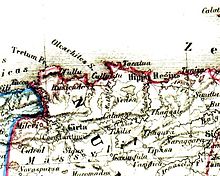Hippo Regius
 Saint Augustin Basilica overlooking the ruins of Hippo Regius | |
| Location | Algeria |
|---|---|
| Region | Annaba Province |
| Coordinates | 36°52′57″N 07°45′00″E / 36.88250°N 7.75000°E |
Hippo Regius (also known as Hippo or Hippone) is the ancient name of the modern city of Annaba, Algeria. It historically served as an important city for the Phoenicians, Berbers, Romans, and Vandals. Hippo was the capital city of the Vandal Kingdom from 435 to 439 AD.[1] until it was shifted to Carthage following the Vandal capture of Carthage (439).
It was the focus of several early
History

Hippo is the
A maritime city near the mouth of the river Ubus, it became a Roman
It was conquered by the
About three kilometres distant in the eleventh century, the Berber
Ecclesiastical history
Hippo was an ancient bishopric, one of many suffragans in the former
The diocese was established around 250 AD. Only these six bishops of Hippo are known:
- Saint Theogenes[8](256? – martyr 259?)
- Saint Leontius[8] (died 303?)
- Fidentius (martyr ?304)
- Valerius (388?–396), who ordained St. Augustine
- the "Doctor of Grace", Saint Augustine (354 – 28 August 430, coadjutor in 395, bishop in 396)
- Heraclius (coadjutor in 426, bishop in 430).
It was suppressed around 450 AD.
Council of Hippo
Three church councils were held at Hippo (393, 394, 426)[5] and more synods – also in 397 (two sessions, June and September) and 401, all under Aurelius.[9]
The synods of the Ancient (North) African church were held, with but few exceptions (e.g. Hippo, 393; Milevum, 402) at Carthage. We know from the letters of Saint Cyprian that, except in time of persecution, the African bishops met at least once a year, in the springtime, and sometimes again in the autumn. Six or seven synods, for instance, were held under St. Cyprian's presidency during the decade of his administration (249–258), and more than fifteen under Aurelius (391–429). The Synod of Hippo of 393 ordered a general meeting yearly, but this was found too onerous for the bishops, and in the Synod of Carthage (407) it was decided to hold a general synod only when necessary for the needs of all Africa, and it was to be held at a place most convenient for the purpose. Not all the bishops of the country were required to assist at the general synod. At the Synod of Hippo (393) it was ordered that "dignities" should be sent from each ecclesiastical province. Only one was required from Tripoli (in Libya), because of the poverty of the bishops of that province. At the Synod of Hippo (393), and again at the Synod of 397 at Carthage, a list of the books of Holy Scripture was drawn up,[9] and these books are still regarded as the constituents of the Catholic canon.
Titular episcopal see
The Hippo(ne) diocese was nominally revived in 1400 as Catholic Latin
It ceased to exist on 23 September 1867, when the see was formally united with the Roman Catholic Diocese of Constantine.
See also
- Auzia
- Caesarea of Mauretania
- Cirta
- Chullu
- Mauretania Caesariensis
- Milevum
- List of cultural assets of Algeria
Notes
- ^ "A Berber, born in 354 at Thagaste (now Souk-Ahras) in Africa, he died as Bishop of Hippo (later Bone, now Annaba) in 430, while the Vandals were besieging the town."Braudel 1995, p. 335
References
- ^ Merrills & Miles 2009.
- ^ Head et al. 1911, p. 886.
- ^ Ghaki 2015, p. 66.
- ^ Brown (2013), p. 326.
- ^ a b c d Pétridès 1910.
- ^ Portalié 1907.
- ^ Merrills & Miles 2009, p. 60.
- ^ a b Tabbernee 2014.
- ^ a b Havey 1907.
Sources
- ISBN 978-0-14-012489-7.
- Brown, Peter (2013), Through the Eye of a Needle: Wealth, the Fall of Rome, and the Making of Christianity in the West, 350–550 AD, Princeton: Princeton University Press, ISBN 978-1400844531
- Ghaki, Mansour (2015), "Toponymie et Onomastique Libyques: L'Apport de l'Écriture Punique/Néopunique" (PDF), La Lingua nella Vita e la Vita della Lingua: Itinerari e Percorsi degli Studi Berberi, Studi Africanistici: Quaderni di Studi Berberi e Libico-Berberi (in French), vol. 4, Naples: Unior, pp. 65–71, ISSN 2283-5636
- Havey, Francis Patrick (1907). . In Herbermann, Charles (ed.). Catholic Encyclopedia. Vol. 1. New York: Robert Appleton Company.
- Head, Barclay; Hill, G.F.; MacDonald, George; Wroth, W. (1911), "Numidia", in Ed Snible (ed.), Historia Numorum (2nd ed.), Oxford: Clarendon Press, pp. 884–887
- Merrills, Andrew; Miles, Richard (2009). The Vandals. John Wiley & Sons. ISBN 978-1-4443-1808-1.
- Pétridès, Sophron (1910). . In Herbermann, Charles (ed.). Catholic Encyclopedia. Vol. 7. New York: Robert Appleton Company.
- Portalié, Eugène (1907). . In Herbermann, Charles (ed.). Catholic Encyclopedia. Vol. 2. New York: Robert Appleton Company.
- Tabbernee, William, ed. (2014). Early Christianity in Contexts: An Exploration across Cultures and Continents. Baker Academic. ISBN 9781441245717.
Further reading
- Laffi, Umberto. Colonie e municipi nello Stato romano Ed. di Storia e Letteratura. Roma, 2007 ISBN 8884983509
- Mommsen, Theodore. The Provinces of the Roman Empire Section: Roman Africa. (Leipzig 1865; London 1866; London: Macmillan 1909; reprint New York 1996) Barnes & Noble. New York, 1996
- Smyth Vereker, Charles. Scenes in the Sunny South: Including the Atlas Mountains and the Oases of the Sahara in Algeria. Volume 2. Publisher Longmans, Green, and Company. University of Wisconsin. Madison,1871 (Roman Hippo Regius)


